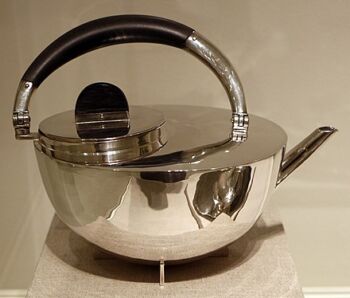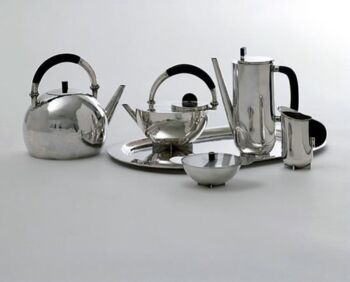Brandt’s tea infuser is the quintessential Bauhaus object, as its geometric structure is the expression of Functionalism.

Brandt’s tea sets use geometric shapes with little ornamentation, which incorporate ideas from other contemporary movements such as Constructivism and De Stijl. The sets use a variegated catalog of materials, such as silver plates, brass, and ebony for the handles. Further, an Italian metalware design company, Alessi, has had the reproduction rights to Brandt’s tea set since 1985.
Features of the Piece
The teapot was one of several prototypes designed and later fabricated by Brandt, when she was still a student. Additionally, she continued production later when she became a teacher, in the Bauhaus metal workshop. The original prototype first came into fruition in 1924, during her first year in the workshop as a trainee.

Image source: https://search.creativecommons.org/photos/5491b67e-be9f-4408-a237-feaf4a9055f8 by moonoa
Moholy-Nagy’s own constructivist roots of similar geometric compositions inspired the design. However, Brandt ensured that the teapot’s form was directly related to its function, which is a maxim that would go on to become a fundamental principle of modern industrial design.
While incorporating the usual shapes and pieces of a teapot, the designer reinvented them as abstract, geometric forms. Unlike conventional teapots, it is intended to distill a concentrated extract, which, when combined with hot water in the cup, can produce tea in any desired percentage.
The body is a hemisphere cradled on crossed bars. The thin circular lid, placed off center to avoid drips has a tall cylindrical knop. Moreover, the handle, a D-shaped slice of ebony set high for ease of pouring, provides a strong vertical contrast to the object’s predominant horizontality.
Although entirely handmade, this teapot has a markedly industrial aesthetic, and Brandt subsequently went on to complete designs for its mass-production. The functionalism of this design is apparent in the neat built-in strainer, the non-drip spout, the off-center lid placement, and the heat-resistant ebony for the handles.
Data Sheet
Designer: Marianne Brandt
Manufacturer: Alessi
Production date: 1924
Materials: Silver and ebony
Dimensions: 8.3 × 10.8 × 16.5 cm
Info source: https://www.metmuseum.org/art/collection/search/491299
